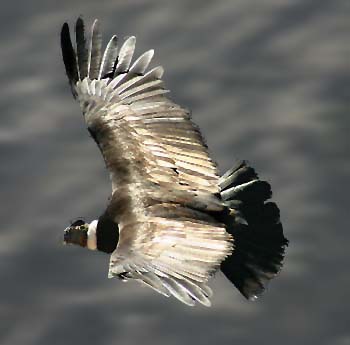Condors live for up to 50 years, developing a canny understanding of the moods and ways of air currents over their local range. Gliding at speeds up to 125 miles an hour, these birds cover tremendous territories looking for dead animals in the sparsely-populated mountains of Patagonia, soaring and circling on thermals in ultimate, low-energy flight. The solitary chick remains in the nest for eight months -- spent mostly alone while the parents forage. It takes six years before the bird grows the white feathers of sexual maturity -- time needed to learn the intricate business of long-distance flying. |
 |
To imagine condor flight is to slip into a dream, in which every feather tests the air and monitors the turbulent gusts --conserving the enormous strength needed to flap those huge wings. Experienced condors take more direct, energy-efficient paths from one peak to another, while the brown juveniles hug the skirts of mountains. Mount Tronador is a training ground for young condors, who follow the distinctive white dorsal wing markings of the adults -- flags that are only visible from above, and may have evolved as a teaching aid for fledglings. With its ten-foot wingspan, the Andean Condor is the world's largest flying animal. However, prehistoric flying reptiles like Hatzegopteryx were seven times larger -- off the chart for birds evolution. These huge pterosaurs may have traveled hundreds of miles to feed. The vanishing condor -- only a few thousand remain -- may be our best glimpse of a younger world, when giants sailed the skies. |
 Custom Search Custom Search |
|
Got a comment? E-Mail us at Feedback@BirdMinds.com
Or visit our new forum for discussion.